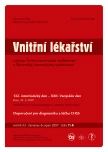Hypopituitarism – substitution therapy
Authors:
V. Olšovská
Authors‘ workplace:
II. interní klinika Lékařské fakulty MU a FN u sv. Anny Brno, přednosta doc. MUDr. Miroslav Souček, CSc.
Published in:
Vnitř Lék 2007; 53(7-8): 812-815
Category:
Overview
Hypopituitarism is a condition linked with insufficient function of the adenohypophyse and occurs in the case of destruction of its greater part. It may take the form of an isolated deficit or a combined disorder – panhypopituitarism. The most common cause is an expansion in the region of sella turcica, irradiation, traumas, inflammations, bleeding, puerperal ischemic necrosis (Sheehan syndrome) or an affection of the hypothalamus. The cause remains unclear in the case of idiopathic hypopituitarism. Clinical picture: the most common case in children is the deficit of the growth hormone, manifested by retarded growth. Sometimes it is combined with the deficit of gonadotropins which causes pubertas tarda. The clinical picture in adult patients is proportionate to the degree and type of disorder of the different hypophysial functions. Diagnosing of the disease is based on the clinical picture and laboratory examination of hypophysial hormones together with the respective peripheral gland hormones. Dynamic stimulation tests need to be used for more precise diagnosis in the case of threshold results. Therapy: expansive processes in the region of the hypophysis are treated by surgery or irradiation, mostly using the gamma knife. Substitution by peripheral gland hormones is used in persistent hormonal deficits. Hypocorticism is treated by hydrocortizone at a dose of 10–30 mg per day administered per os, respecting the diurnal rhythm. The dose should be adjusted in case of strain, and parenterally administered hydrocortizone is necessary in the case of decompensation, pituitary crisis or surgery. Hypothyreosis is treated by thyroxin, the usual substitution dose ranging between 50 and 150 μg per day. The dose is titrated according to the clinical condition and free thyroxin level. Testosterone substitution therapy is used to treat male hypogonadism. In women, a combination of estrogens and gestagens is used on a cyclic or a continuous basis. If fertility is the therapeutic objective, temporary administration of injection gonadotropins or gonadoliberin is necessary in both the sexes. Therapy with growth hormone is indicated in children and in adults with sever, clinically manifested deficit of GH where its administration clearly improves the quality of life, promotes the growth of lean body mass, an increase in bone density and the improvement of metabolic parametres.
Key words:
hypopituitarism – hypothalamus disorders – substitution therapy
Sources
1. Kreze Aet al. Všeobecná a klinická endokrinológia. Bratislava: AEP 2004: 144-152.
2. Larsen PR, Kronenberg H, Melme S et al. William’s Textbook of Endokrinology. Philadephia: SW Saunders 2002: 252-261.
3. Stárka L, Zamrazil V et al. Základy klinické endokrinologie. Praha: Maxdorf 2005: 60-66.
4. Cuneo RC, Salomon F, McGauley GA et al. The growth hormone deficiency syndrome in adults. Clin Endocrinol 1992; 37: 387-397.
Labels
Diabetology Endocrinology Internal medicineArticle was published in
Internal Medicine

2007 Issue 7-8
Most read in this issue
- Hypopituitarism – substitution therapy
- Autoimmune polyglandular syndromes: clinical aspects
- Aspiration cytology of the thyroid
- Randomly discovered enlargement in the region of sella turcica
